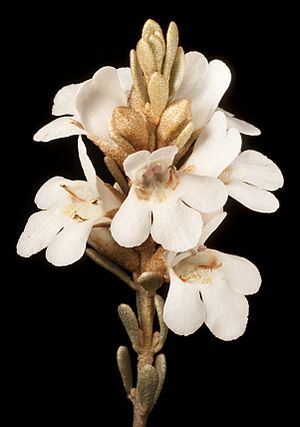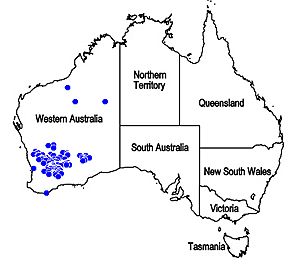Pityrodia lepidota facts for kids
Quick facts for kids Pityrodia lepidota |
|
|---|---|
 |
|
| Pityrodia lepidota leaves and flowers | |
| Scientific classification | |
| Genus: |
Pityrodia
|
| Species: |
lepidota
|
 |
|
| Occurrence data from the ALA | |
Pityrodia lepidota is a special kind of flowering plant. It belongs to the mint family, called Lamiaceae. This plant only grows in the south-west part of Western Australia.
It is a small, bushy shrub with many branches. Its leaves are tiny, and its flowers are shaped like bells, usually whitish. What makes this plant unique is that almost its entire body, except for the flower petals, is covered in small, round scales.
What it Looks Like
Pityrodia lepidota is a thick, bushy shrub with many stems. It usually grows to be about 0.3–0.7 m (1–2 ft) tall. Its branches and leaves are covered in ash-colored, round scales.
The leaves do not have stalks. They are shaped like an egg or a spear, with the narrower end at the bottom. They are about 5–10 mm (0.2–0.4 in) long and 2–3 mm (0.08–0.1 in) wide.
The Flowers
The flowers grow alone or in small groups of two or three. They are found on short, scaly stalks where the leaves meet the stem (called axils). Each flower is surrounded by special leaf-like parts called bracts and tiny bracteoles.
Single flowers have leafy bracts that are 5–10 mm (0.2–0.4 in) long. Flowers in groups have scaly bracts about 2 mm (0.08 in) long.
The flower has five sepals, which are like small leaves that protect the bud. These sepals are 5–6 mm (0.20–0.24 in) long and covered in scales on the outside. They are joined together for about half their length, forming a tube with five rounded tips.
The five petals are 7–10 mm (0.3–0.4 in) long. They can be whitish, light pink, or light purple. These petals also join together to form a bell-shaped tube with five lobes (rounded parts) at the end.
The inside of the tube is mostly smooth, except for a ring of dense hairs around the ovary (where the seeds develop). There are also a few hairs on the lowest petal lobe. This lowest, central lobe is oblong or egg-shaped, about 4–5 mm (0.2–0.2 in) long and 3–4 mm (0.1–0.2 in) wide. The other lobes are a bit smaller.
Life Cycle
Pityrodia lepidota flowers from June to December, and sometimes even as late as March. After the flowers, the plant produces oval-shaped fruits that are hairy. The sepals (the protective parts) stay attached to the fruit.
How it Got its Name
This plant was first officially described in 1883 by a scientist named Ferdinand von Mueller. He first called it Chloanthes lepidota. Later, in 1904, Georg Pritzel changed its name to Pityrodia lepidota.
The second part of its name, lepidota, comes from a Latin word, lepidotus. This Latin word comes from an ancient Greek word, lepidōtos, which means "scaled." This makes sense because the plant is covered in scales!
Where it Grows
This type of pityrodia plant likes to grow in sandy or gravelly soils. You can find it on sandplains and sand dunes.
It is mostly found between the towns of Merredin and Coolgardie in Western Australia. It can be found as far north as Mongers Lake near Perenjori and Lake Moore near Wubin. It also grows as far south as the road between Lake King and Lake Grace.
Its home covers several different natural areas, including the Avon Wheatbelt, Coolgardie, Great Victoria Desert, Mallee, and Murchison regions.
Is it Safe?
The Western Australian Government's Department of Parks and Wildlife has looked at Pityrodia lepidota. They have classified it as "not threatened." This means the plant is not currently in danger of disappearing.

